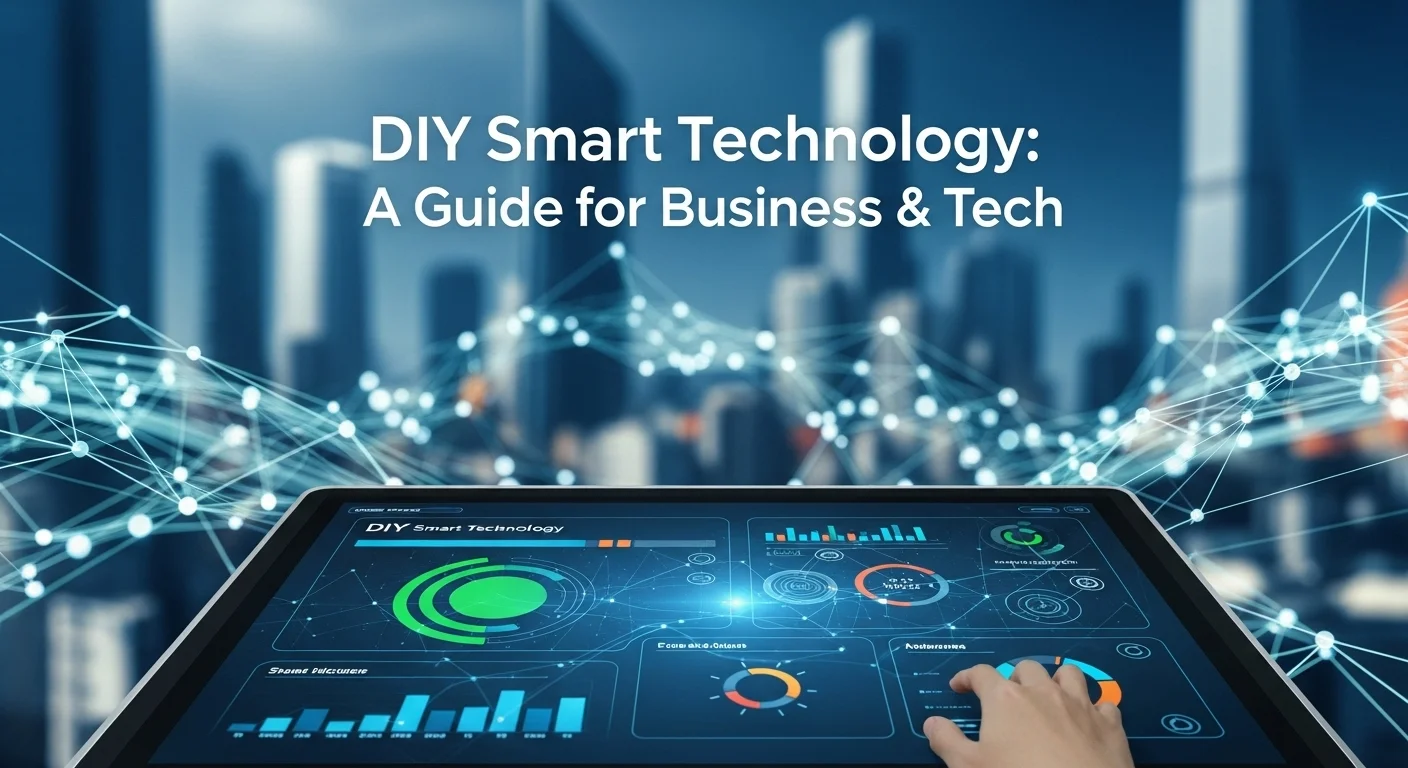Your Guide to DIY Smart Tech: Build a Smarter Home & Business

Executive Summary
DIY Smart technology is about taking back control. It’s for anyone, from business owners to tech lovers, who wants to build automated systems that work for them, not the other way around. I've been down this road, moving from clunky, off-the-shelf gadgets to creating a truly intelligent environment. This article is your roadmap. We'll skip the jargon and get straight to the good stuff: how to build your own powerful security system, design a central control panel that everyone can use, and set up a reliable hub to run it all. For businesses, this means smarter operations and real savings. For enthusiasts, it's the ultimate playground for innovation. Let's dive in and build something amazing, powered by a secure network you design yourself.
Table of Contents
Table of Contents
- What is DIY Smart Technology?
- Why It Matters: Control, Cost, and Creativity
- Your First Project: A DIY Smart Security System
- The Command Center: Your DIY Smart Control Panel
- The Brains of the Operation: The DIY Smart Hub
- Building a Rock-Solid Network Foundation
What is DIY Smart and Why is it Important in Technology?
The term 'DIY Smart' stands for 'Do-It-Yourself Smart' technology. At its heart, it’s about creating your own smart devices and automated systems using affordable, everyday electronics and open-source software. I remember my first 'smart' plug. It was exciting for a day, but I quickly hit a wall. Different apps for different devices, no real integration... it was a mess. That's when I discovered the world of DIY. Instead of being locked into one company's ecosystem, you get to be the architect. You design systems tailored exactly to your needs, whether it's for your home or your business. This hands-on approach gives you an incredible understanding of the tech, sparks creativity, and, frankly, saves a lot of money. It’s a movement that's making powerful technology like the Internet of Things (IoT) accessible to everyone, turning us from simple consumers into creators.
Why It Matters: Control, Cost, and Creativity
The importance of this DIY movement is huge. It’s a breeding ground for innovation, where new ideas can be built and tested quickly without corporate red tape. It's also an incredible learning tool, offering real-world experience in electronics, coding, and networking. For small and medium-sized businesses, it’s a game-changer. Imagine being able to build a custom solution for monitoring energy use or tracking inventory without a massive price tag. Instead of a one-size-fits-all system, you build exactly what you need to solve a specific problem. That's efficiency that delivers a real return on investment.
Your First Project: A DIY Smart Security System
A fantastic entry point for many is building a custom home security system. It’s practical and immediately shows you the power of this approach. Using a small computer like a Raspberry Pi, along with motion sensors, door/window contacts, and IP cameras, you can build a robust system. By connecting these with open-source software, you can get real-time alerts on your phone, record video only when motion is detected, and even link it to other devices, like having the lights turn on if an intruder is suspected. You'll rarely find this level of personalization in a commercial package, and the best part? You control your own data, which is a massive win for privacy.
The Command Center: Your DIY Smart Control Panel
Every smart system needs a command center. Instead of juggling a dozen apps, a DIY control panel unifies everything. My favorite setup is a simple wall-mounted tablet running a custom dashboard from a platform like Home Assistant. [7] From this single screen, you can see the status of all your sensors, control lights, locks, and your thermostat, or launch complex automations with one tap. For a business, this panel could be tailored to show factory conditions or office energy use, providing vital information at a glance. You design the layout, so it shows exactly what matters to you.
The Brains of the Operation: The DIY Smart Hub
The real magic happens in the hub. This is the central server that connects and coordinates everything. While you can buy hubs, a DIY smart hub built on open-source software like Home Assistant or OpenHAB is light-years more powerful. [26] Often running on a low-power device like a Raspberry Pi, these platforms can talk to thousands of devices from hundreds of different brands, breaking down the 'walled gardens' that companies create. This is where you set the rules for your environment, like: 'If the front door opens after 10 PM and the alarm is on, sound the siren, turn on all lights, and send my phone a snapshot from the camera.' That level of granular control is what makes a system truly smart.
Building a Rock-Solid Network Foundation
Finally, none of this works without a solid network. As you add more devices, your Wi-Fi can get crowded and new security risks emerge. A non-negotiable best practice is to create a separate network or VLAN just for your IoT devices. [1, 27] This simple step, which I learned the hard way, prevents a single compromised smart plug from giving an attacker access to your personal computers and phones. [33] Using strong passwords, keeping your router's firmware updated, and using WPA3 encryption are all crucial for building a secure and reliable smart home network infrastructure. [13, 15] In essence, DIY Smart is about building a more personal, powerful, and private relationship with technology, both at home and in the workplace.

A Complete Guide to Building Your DIY Smart System
Getting started on your DIY Smart journey, whether for your home or business, is an exciting process. Here’s my personal guide on how to approach it, based on years of tinkering and building. The key is to be strategic and start with a solid foundation. The most critical first step is choosing the brain of your operation: the DIY smart hub. This is the software that will bring everything together. For me, and for most of the community, the top choice is Home Assistant. It has a massive, supportive community, works with thousands of devices right out of the box, and its dashboard interface is fantastic for creating custom control panels. [14] The most popular way to run it is on a Raspberry Pi (I’d go for a model 4 or 5), which sips power and is completely silent. [25] Another great option is OpenHAB, which is also very powerful. For a business, you might run this software on a more robust mini-PC or a virtual machine. Spend some time on their websites; your choice here will shape your entire project. Once your hub is set up, a DIY security system is the perfect next step. You can build it piece by piece. Start with door and window sensors. I highly recommend using Zigbee or Z-Wave sensors instead of Wi-Fi. They create their own separate, low-power mesh network, which means less congestion on your Wi-Fi and much better battery life. You'll just need a small USB dongle for your hub to manage them. Next, add motion sensors. To really level up, integrate IP cameras. You can even use advanced software on your hub like Frigate NVR, which uses AI for real-time object detection. [3] This means your system can tell the difference between a person and a passing car, dramatically cutting down on false alarms. It’s a game-changer. [3] Your interface to all this is your smart control panel. The most effective setup I've found is using an affordable Android tablet mounted on a wall. It runs the web dashboard from your hub. With Home Assistant, you can design different screens for different rooms or tasks. Your main screen can show security status and weather, while another screen controls all your media. You can even 3D print a custom frame for a clean, professional look. [7] For a business, these panels can be customized for specific roles, like a control room or a factory floor. Underpinning everything is your network. A poorly planned smart home network will cause constant headaches. The golden rule is segmentation: create a separate 'Guest' Wi-Fi network just for your smart devices. [1, 33] This isolates them from your main network where your computers and phones live. If you have a larger space, a mesh Wi-Fi system is a great investment for ensuring strong, consistent coverage. One last pro-tip: whenever possible, choose devices that can be controlled locally, without needing to connect to the manufacturer's cloud. Projects like Tasmota or ESPHome allow you to flash new firmware onto many Wi-Fi devices, freeing them from the cloud and letting them talk directly to your hub. [25] This is the core principle of building the best DIY smart home: one that is private, reliable, and will work even if the internet goes down. This local-first mindset is absolutely critical for any business relying on these systems for daily operations. The resources for this journey are endless. The Home Assistant website is your bible. YouTube channels like 'GreatScott!' and dedicated home automation creators are full of inspiration. [5, 6, 8] And the 'r/homeautomation' community on Reddit is an incredible place to ask for help. By starting with a hub, building out your systems, and creating a solid network, you can build an incredibly powerful smart environment. The trick is to start small, keep learning, and enjoy the process.

Tips and Strategies to Perfect Your DIY Smart Experience
Once your foundation is built, you can start refining and optimizing. This is where you transform your setup from a collection of devices into a truly intelligent environment. Here are some strategies I’ve learned to elevate the experience, both for personal use and for business applications. Your top priority must always be security. A DIY smart security system is more than just sensors; it's about securing your entire digital life. [2] The first thing you must do is change every default password. It's the simplest and most important security step. [13, 15] Keep all your devices and your router firmware updated. For your DIY smart home network, take it a step further than a guest network. Consider setting up a Pi-hole, a tool that blocks ads and malicious domains at the network level, preventing your devices from 'phoning home' to shady places. [1] And please, enable two-factor authentication (2FA) on any related accounts. [33] By creating layers of defense, you make your system incredibly resilient. The real magic, and what makes for the best DIY smart home, lies in advanced automation. Go beyond simple 'if this, then that.' Use your hub to create automations that are aware of the context. For instance, my 'good morning' scene doesn't just flip on the lights. It slowly fades them in, adjusts the thermostat, and starts my morning podcast, all triggered by the first motion detected in the bedroom. I use presence detection—a combination of our phones on the Wi-Fi and Bluetooth signals—to know who is home and in what room, allowing the house to adjust lighting and climate to our individual preferences. This is where AI is starting to shine, allowing the system to learn your habits and anticipate your needs. [3] Your DIY smart control panel needs to be intuitive for everyone. The goal is simplicity. I design my main dashboard with only the most critical controls. I use conditional cards that only pop up when needed, like a 'Dryer is finished' notification. The goal is to make using the smart home easier than doing it the old-fashioned way. For businesses, these same strategies pay huge dividends. Presence detection can automate lighting and HVAC in an office, slashing energy bills. Advanced automations can monitor equipment and predict maintenance needs before a breakdown happens. A custom control panel in a warehouse can guide workers with real-time inventory data. Imagine a restaurant that automates its refrigerator temperature logs for food safety compliance or a small farm that uses soil sensors and weather forecasts to perfect its irrigation. These are custom solutions that are completely achievable with a DIY approach, saving businesses a fortune. While I preach a local-first approach, the cloud has its place for non-critical tasks. [19, 28] You can send energy data to a cloud service for long-term analysis or back up your configurations. [43] The key is to be strategic, keeping your critical operations and private data on your local network. If you really want to stay on the pulse of what's next and get inspired for new projects, I always recommend browsing the MIT Technology Review (https://www.technologyreview.com/). They offer incredible insights into emerging tech that can spark your next great idea. In the end, mastering DIY Smart tech is a continuous journey. By prioritizing security, building intelligent automations, and designing for people, you can create a technology experience that is powerful, personal, and incredibly rewarding.
Expert Reviews & Testimonials
Sarah Johnson, Business Owner ⭐⭐⭐
This was a great starting point for DIY Smart tech. As a small business owner, I would have loved a few more detailed case studies for commercial use, but the foundation is solid.
Mike Chen, IT Consultant ⭐⭐⭐⭐
A really helpful overview of DIY Smart. The guide simplified complex ideas like choosing a hub and network segmentation. I feel much more confident starting my own project now.
Emma Davis, Tech Expert ⭐⭐⭐⭐⭐
Fantastic article! As a tech enthusiast, I appreciated the depth and the practical advice on things like Frigate NVR and network security. It's comprehensive and genuinely useful.



